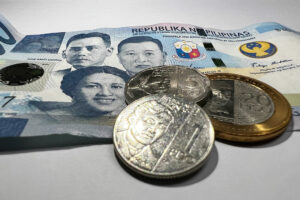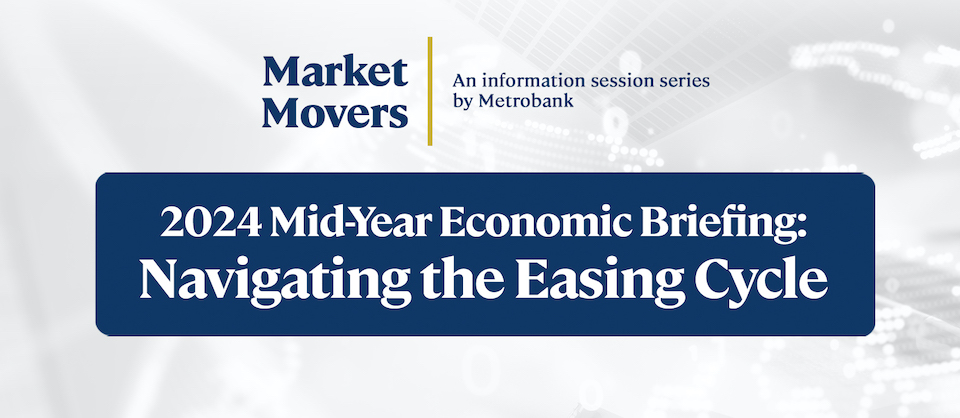




Policy Rate Updates: Closer to BSP’s Goldilocks moment
 DOWNLOAD
DOWNLOAD

Inflation Update: Speeds up but remains below target
 DOWNLOAD
DOWNLOAD

Monthly Economic Update: Fed back on track
 DOWNLOAD
DOWNLOAD


Peso weakens vs dollar ahead of US PPI data

The peso weakened against the dollar on Thursday as players repositioned before the release of July US producer inflation data overnight.
The local unit closed at PHP 56.945 per dollar, dropping by 22.5 centavos from its PHP 56.72 finish on Wednesday, Bankers Association of the Philippines data showed.
The peso opened the session a tad stronger at P56.70 against the dollar. It climbed to as high as PHP 56.61, while its worst showing was at PHP 56.995 against the greenback.
Dollars exchanged rose to USD 1.87 billion on Thursday from USD 1.63 billion on Wednesday.
“The dollar-peso initially fell to lows of PHP 56.61 on dovish Fed bets but later reached highs of PHP 56.955 on profit taking and trimming of positions ahead of US PPI (producer price index) data,” a trader said in a phone interview.
The US dollar rose slightly against other major currencies on Thursday, but stayed close to multi-week lows as bets that the Federal Reserve will resume cutting interest rates next month ticked higher, Reuters reported.
Fed rhetoric has turned broadly more dovish on signs of a cooling US labor market, while President Donald J. Trump’s tariffs are yet to add significantly to price pressures.
Traders see a Fed rate cut on Sept. 17 as a near certainty, according to LSEG data, and even lay around 7% odds on a super-sized half-point reduction.
The Fed also continues to be under intense political pressure to ease.
Mr. Trump has repeatedly criticized Fed Chair Jerome H. Powell for not cutting rates sooner, even threatening to oust him before Mr. Powell’s term expires in May.
Treasury Secretary Scott Bessent on Wednesday called for a “series of rate cuts,” and said the Fed could kick off the policy easing with a half-point cut.
Francesco Pesole, FX strategist at ING, said a 50 basis points rate cut is not very realistic right now.
“In order for the market to price 50 basis points in, we would probably need some indication from other Fed members that they are somewhat open to the idea,” he said.
Traders are now looking ahead to US PPI figures for July due later in the session.
“If that comes in soft or below expectations that can add a little bit of easing,” said ING’s Mr. Pesole.
Meanwhile, the peso was also dragged lower by “estimates of higher national government borrowings and outstanding debt for 2026,” Rizal Commercial Banking Corp. Chief Economist Michael L. Ricafort said in a Viber message.
The 2026 Budget of Expenditures and Sources of Financing showed that the National Government’s (NG) outstanding debt is expected to increase by 9.78% to a record PHP 19.06 trillion by end-2026 from the revised PHP 17.36-trillion estimate for end-2025.
As of June, the Philippines’ outstanding debt hit a fresh high of PHP 17.27 trillion, up 11.5% from PHP 15.48 trillion in the same month in 2024.
This brought the debt-to-gross domestic product (GDP) ratio to 63.1% at the end of June, the highest ratio since 2005. This is above the 60% debt-to-GDP threshold considered by multilateral lenders to be manageable for developing economies.
Meanwhile, the NG’s gross borrowing program for 2026 was set at PHP 2.68 trillion, up 3.15% from PHP 2.6 trillion this year.
For Friday, the trader sees the peso moving between PHP 56.70 and PHP 57.10 per dollar, while Mr. Ricafort expects it to range from PHP 56.80 to PHP 57.10. — Aaron Michael C. Sy with Reuters
This article originally appeared on bworldonline.com





 By BusinessWorld
By BusinessWorld